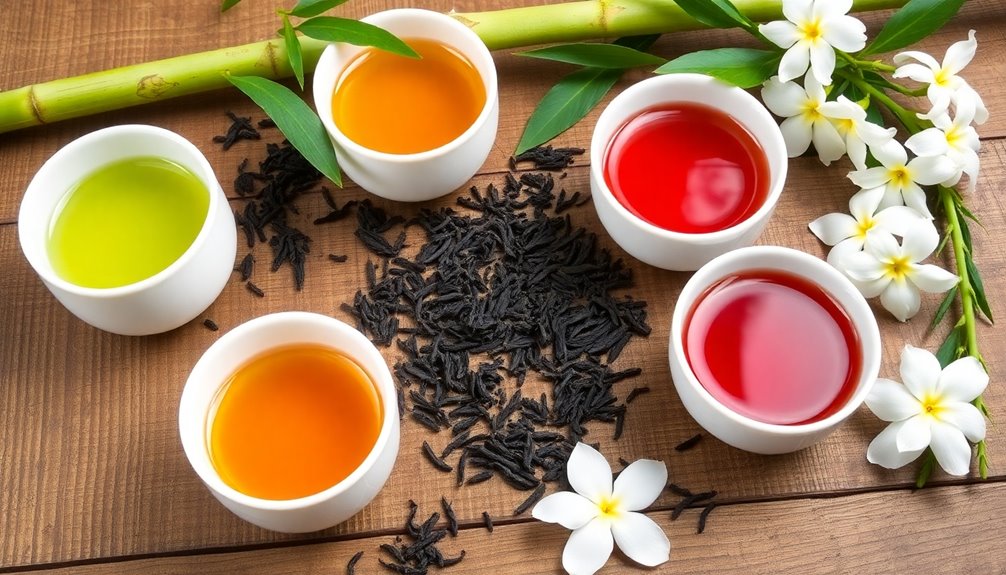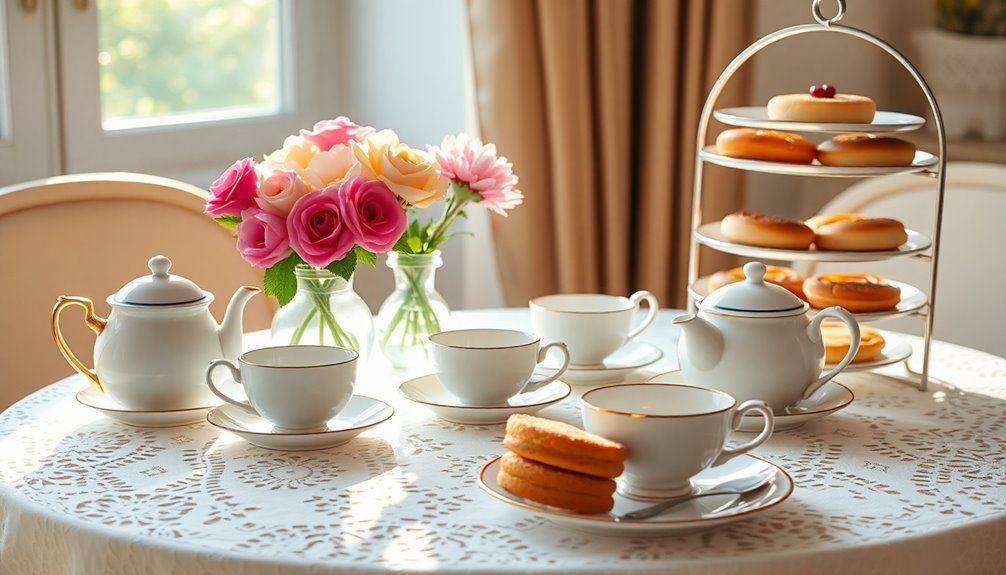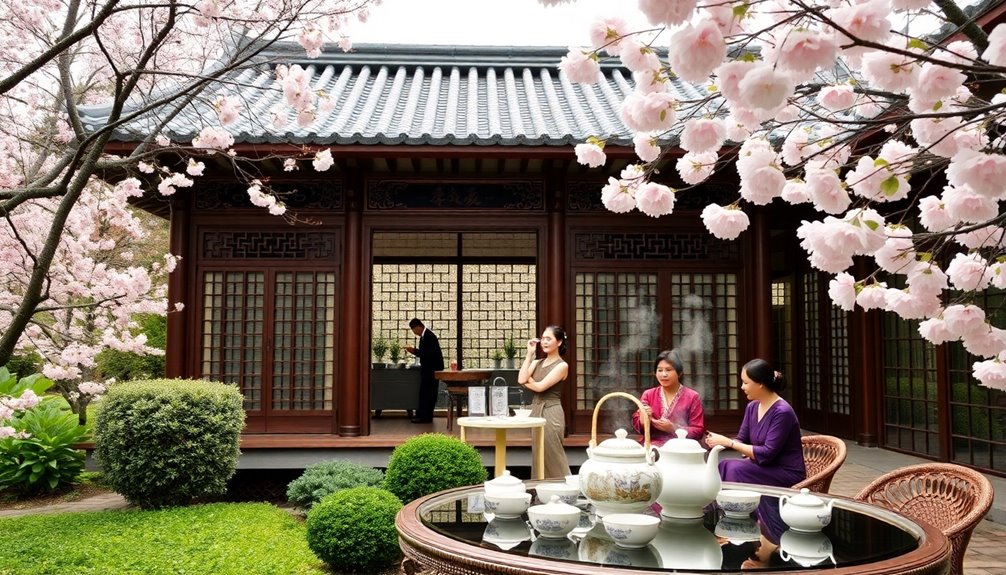If you're looking to explore the best Chinese teas, you've got to try Xihu Longjing for its sweet flavor, and Bi Luo Chun, known for its fruity aromas. Don't miss Huang Shan Mao Feng from Anhui for a delicate brew, and Tie Guan Yin, an oolong with complex orchid fragrances. For something robust, Keemun black tea offers malty experiences, while Silver Needle white tea is a must for its subtle sweetness. Each tea offers a unique taste of China's rich culture. Keep going, and you'll discover even more about what makes these teas truly special.
Key Takeaways
- Longjing (Dragon Well): A premium green tea known for its sweet, vegetal flavor, originating from Hangzhou, Zhejiang Province.
- Tie Guan Yin (Iron Goddess of Mercy): An oolong tea with complex flavors and orchid fragrance, popular for its smooth and rich taste.
- Wuyi Rock Tea (Da Hong Pao): Renowned for its balanced taste with subtle mineral notes, this black tea represents the essence of Wuyi's rocky terrain.
- Bi Luo Chun (Green Snail Spring): A fragrant green tea from Dong Ting Mountain, celebrated for its fruity aromas and delicate, sweet profile.
- Silver Needle (Bai Hao Yinzhen): A top-quality white tea known for its delicate flavor and subtle sweetness, made from young tea buds.
Introduction

Tea embodies a rich tapestry of culture and tradition, particularly in China, where its significance has evolved over thousands of years. You'll find that Chinese tea culture isn't just about drinking; it reflects a blend of history, social interaction, and artistry.
Initially rooted in medicinal practices, tea has transformed into a refined art form, celebrated globally.
The emergence of the "Top Ten Teas" list in 1915 highlighted premium varieties like green tea, black tea, and oolong tea. Among these, Xihu Long Jing (Dragon Well) stands out for its sweet flavor and exclusive cultivation near West Lake.
Bi Luo Chun, or Green Snail, enchants with its fruity aroma and rich historical significance. Oolong teas, such as Anxi Tie Guan Yin, and black teas like Imperial Keemun, are revered for their complex flavors and unique processing techniques, catering to various palates.
Tea's cultural significance extends beyond taste; it serves as a social beverage and a symbol of status, often gifted to emperors as tribute.
Regional Tea Cultivation Practices
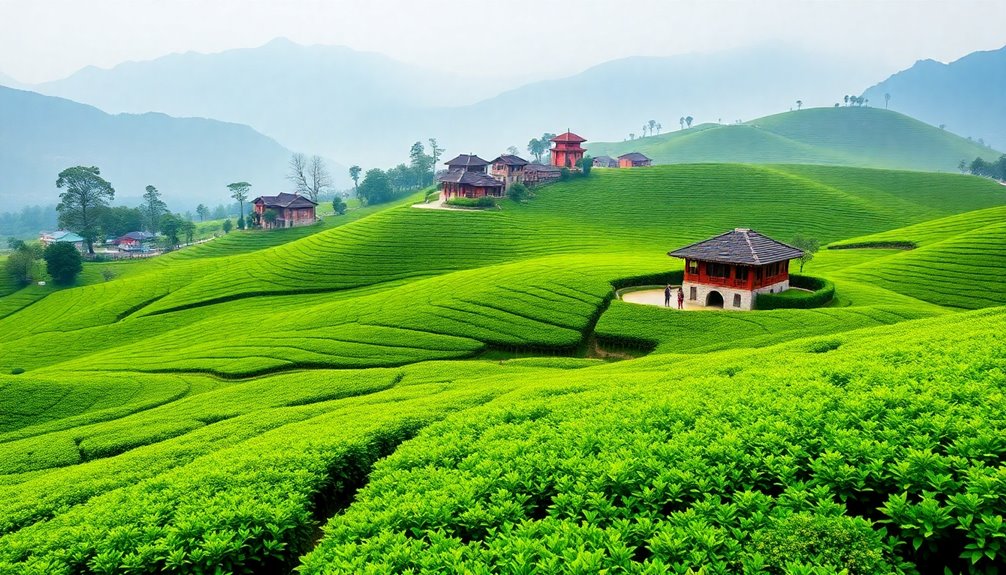
Across China, diverse geographical regions contribute to the rich variety of tea flavors, each shaped by unique climate conditions and soil types.
In Anhui Province, for instance, the high-altitude growth of Huang Shan Mao Feng leads to a delicate and fragrant brew. Traditional practices like hand-picking ensure that only the finest leaves, such as those used in Xihu Long Jing, are chosen, enhancing quality.
Timing is everything in regional tea cultivation. The spring flushes yield aromatic gems like Bi Luo Chun from Dong Ting Mountain, capturing the essence of the season.
Meanwhile, Fujian Province is renowned for its oolong tea, where specific processing techniques such as withering and oxidation create distinct flavor profiles that are hard to replicate elsewhere.
Many tea farms across China stick to centuries-old cultivation methods, prioritizing organic practices that promote biodiversity.
These sustainable approaches not only maintain the health of the tea plants but also safeguard the surrounding ecosystems.
Flavor Profiles Vary Widely
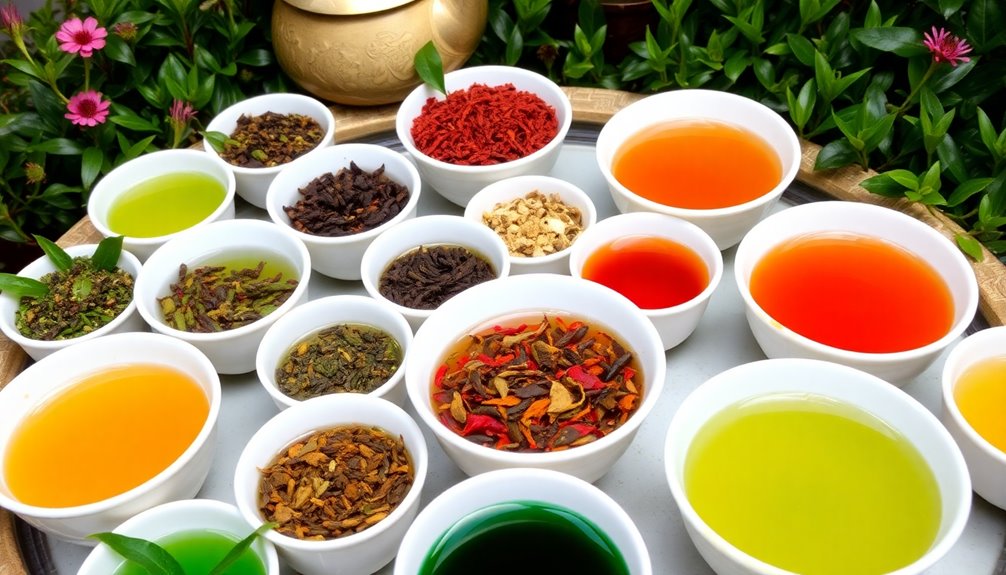
The rich tapestry of regional tea cultivation not only shapes the character of the leaves but also influences the diverse flavor profiles you'll encounter.
When exploring Chinese teas, you'll find that each type offers a unique experience. For instance, green teas like Longjing bring sweet, vegetal notes, while Bi Luo Chun delights with fruity aromas and floral hints.
Oolong teas, such as Tie Guan Yin, present complex flavor profiles that feature a natural orchid fragrance and a rich, creamy texture. On the other hand, Wuyi Rock Tea impresses with a well-balanced taste, accentuated by a subtle mineral essence.
If you're drawn to bold flavors, black teas like Keemun deliver a robust, malty experience, enriched by floral and sweet undertones that make them favorites among connoisseurs.
For something lighter, white teas, especially Silver Needle, are known for their delicate flavor and subtle sweetness, thanks to their minimal processing.
Lastly, yellow teas like Junshan Yinzhen offer a mellow sweetness and smooth texture, resulting from a unique fermentation process that sets them apart from green teas.
Each cup you sip tells a story of its origin.
Tea's Role in Chinese Culture
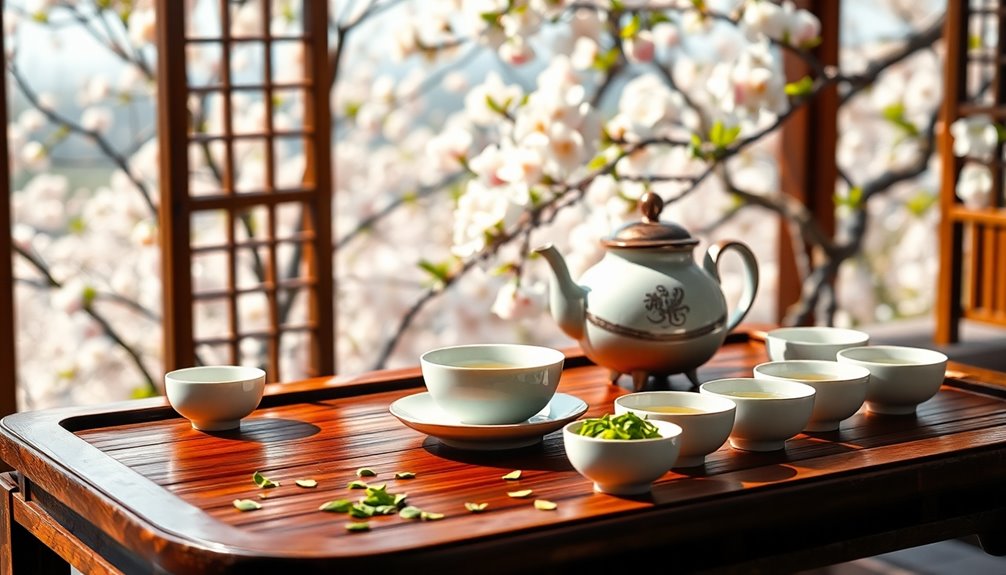
In Chinese culture, tea isn't just a beverage; it's a vital thread woven into the fabric of social interaction and tradition. For centuries, tea has influenced social practices and ceremonies, embodying hospitality and respect in ways that reflect both status and regional identity.
When you participate in a traditional tea ceremony, you experience the aesthetic presentation alongside the taste, which highlights the beauty and ritual involved in tea preparation.
The significance of tea extends beyond mere enjoyment; exceptional varieties have historically been gifted as tributes to emperors, showcasing their importance within the social hierarchy. Each region boasts its own unique teas, enhancing the cultural tapestry by linking specific flavors to geographical locations.
This regional diversity deepens your appreciation for the rich history and traditions that accompany tea drinking.
Today, modern tea culture continues to celebrate these traditional practices while adapting to contemporary tastes. As you explore the world of Chinese tea, you'll find a robust community of tea enthusiasts, both domestically and globally, fostering connections through shared appreciation.
Immerse yourself in this vibrant culture, and you'll discover that tea is truly a reflection of Chinese identity and social bonds.
Quality Control Issues

Quality control issues in the Chinese tea industry have become a pressing concern for consumers and producers alike. Inconsistent standards across regions lead to variations in taste and safety, making it challenging to find reliable tea. The use of pesticides and chemical fertilizers in tea production has raised alarms, prompting a shift towards organic and sustainable practices.
Many consumers are now wary of potential contaminants, and recent studies reveal that a significant percentage of Chinese teas may indeed harbor harmful substances. This growing awareness among consumers has driven demand for certifications such as organic and fair trade.
These certifications encourage reputable producers to adopt better practices, ensuring that their products meet higher quality standards. While regulatory bodies have implemented stricter quality control measures, the enforcement remains uneven, leaving some consumers uncertain about the tea they purchase.
To navigate these quality control issues, it's crucial for you to prioritize sourcing tea from reputable producers who are committed to sustainable practices. By doing this, you not only support the environment but also enjoy a safer and higher-quality tea experience.
Keep an eye out for certifications and stay informed about the tea you choose to drink.
Practical Applications

Exploring Chinese teas opens up a world of flavors and experiences that can elevate your tea-drinking journey. Start with Long Jing (Dragon Well) and Bi Luo Chun, both celebrated for their unique flavors and rich history.
For a refreshing sip, brew Huang Shan Mao Feng at lower temperatures to reveal its sweet, mellow taste while enjoying its health benefits, like improved heart health.
When you prepare Tie Guan Yin (Iron Goddess), remember its semi-fermented nature; this gives it a complex floral aroma that oolong tea lovers adore.
Don't miss out on Keemun Black Tea, known as the queen of black teas. Pair it with light snacks to enhance its robust, malty flavors—these are favorites of the British Royal Family.
For a deeper appreciation of Wuyi Rock Tea, use a gaiwan for brewing. This method amplifies its well-balanced taste and allows the unique "rock rhyme" qualities to shine through.
Conclusion
In exploring the best Chinese teas, you've discovered a world of diverse flavors and rich cultural significance. From the lush hills of Yunnan to the misty mountains of Fujian, each region offers unique experiences. Remember, quality matters, so seek out reputable sources to ensure you're getting the best. Whether you're sipping a delicate green tea or a robust black tea, embracing these traditions can deepen your appreciation for this ancient beverage. Enjoy your tea journey!

